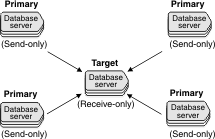Data consolidation
Businesses can choose to consolidate data into one or more central database servers.
Data consolidation allows the migration of data from several database servers to a central database server. For example, several retail stores can replicate inventory and sales information to headquarters. The retail stores do not need information from other stores but headquarters needs the total inventory and sales of all stores.

You can also use data consolidation to replicate data from many database servers to more than one central database server. For example, a retail chain has two central database servers, one for the eastern half of the United States, and one for the western half of the United States. The retail stores replicate data to their designated central server and the two central servers replicate data to each other. In this configuration, the replication servers in the retail stores only send data to the central servers, but the central servers both send and receive data.
Businesses can use data consolidation to replicate OLTP data to a dedicated computer for decision support (DSS) analysis. For example, data from several OLTP systems can be replicated to a DSS system for read-only analysis.
The replication key for every replicated row must be unique among the multiple primary database servers.
You specify that a server only sends information when you define the participant for the server as part of the replicate definition. You can specify that all replicates on a server only send information when you modify the server definition.